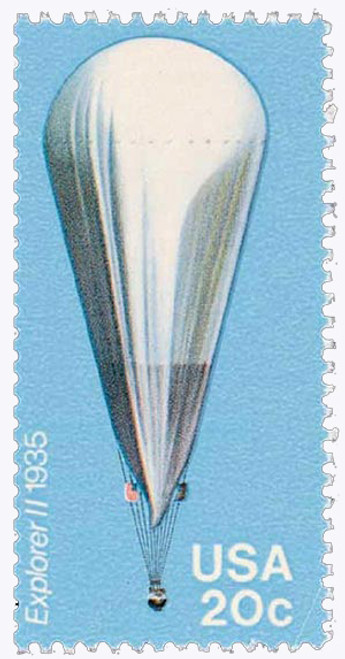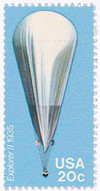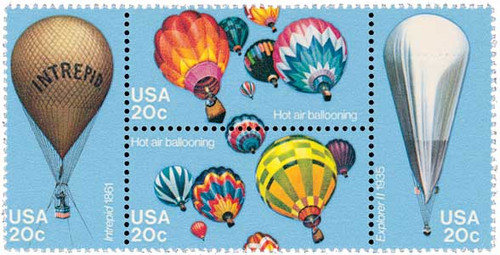
# 2035 - 1983 20c Balloons: Explorer II
U.S. #2035
1983 20¢ Explorer II
Balloons
- Issued for 200th anniversary of first manned balloon flight
- 2 First Day Ceremonies – one included balloon flight
- Pictures Explorer II, used by the Army and National Geographic for scientific experiments
Stamp Category: Commemorative
Set: Balloons
Value: 20¢, first-class rate
First Day of Issue: March 31, 1983
First Day City: Albuquerque, New Mexico and Washington, DC
Quantity Issued: 56,532,000
Printed by: Bureau of Engraving & Printing
Printing Method: Photogravure
Format: Panes of 40 in sheets of 160
Perforations: 11
Why the stamp was issued: To commemorate the 200th anniversary of the first manned balloon flight in 1783.
About the stamp design: The Balloons block was the first stamp issue designed by Davis Meltzer, a freelance artist from the National Geographic Society. He created paintings based on photos and artwork. Explorer II was used by the National Geographic Society and the US Army in 1935 for scientific experiments. This balloon was filled with helium, which was expensive, but far less dangerous than the hydrogen used in the Intrepid.
First Day Cities: The First Day for the Balloons block changed several times before being settled on March 31. The block also had two First Day sites – Albuquerque, New Mexico and Washington, DC. Albuquerque has been host so to many ballooning events over the years, it came to be known as the “Ballooning Capital of the World.”
The First Day ceremony in Washington, DC was one of the most elaborate of the year. It included an appearance by a 100-foot by 50-foot balloon replica of Forbes magazine’s editor Malcolm S Forbes Normandy Chateau. The functioning balloon was crafted with amazing detail, matching the chateau’s façade, roof, and chimneys. The ceremony took place at the foot of Capitol Hill, which is prohibited air space. So, the USPS had to obtain special permission to fly the balloon during their event. Forbes and Postmaster General William F. Bolger took two balloon flights during the First Day ceremony, carrying a limited number of signed First Day covers.
Unusual fact about this stamp: Error stamps have been found entirely imperforate or misperforated, with the perforations off by several millimeters.
About the Balloons Stamps: It’s estimated that about 50 countries issued stamps honoring the 200th anniversary of the first balloon flight in 1983. The USPS was so impressed with the images on these stamps, they made ballooning the central theme of their spring promotion that year, with slogans reading “Get Carried Away with Philately.”
Other Stamps in the Set Picture:
Intrepid (#2032) was used by the Union Army during the Civil War. It was piloted by Thaddeus Lowe, who reported on enemy positions every 15 minutes.
Modern hot-air balloons (#2033 and #2034) were pictured on two center horizontal stamps in the block. The stamps show a variety of multi-colored modern hot-air balloons.
History this stamp represents: In 1782, Joseph Montgolfier was sitting in front of a fire when he began to wonder about the force that made the smoke and sparks rise into the night sky. He took a shirt, tied off the collar and held it above the fire. To his surprise, this force (later called Montgolfier gas) made the shirt rise.
Joseph and his brother, Étienne, had a passion for flight. They soon began experimenting in their hometown in the south of France. Their early experiments consisted of filling balloons made from paper-lined silk with hot air and watching them rise. As the experiments continued, larger balloons were used and the tests were harder to conceal.
After several failed attempts to make a bag full of hot air rise, the Montgolfier brothers gave their first public demonstration on June 4, 1783. Joseph and Étienne fashioned a balloon out of light fabric. The 28,000-cubic-foot balloon was lined with paper, coated with fireproofing, and held together with 2,000 buttons. Operating with the mistaken belief that smoke – not hot air – would cause the balloon to rise, the fire was fed with straw, wool, and old shoes. Although they didn’t understand the physics of their experiment, the balloon rose more than 3,000 feet into the air and traveled more than two miles.
The Montgolfier brothers surpassed their initial success a few months later, on September 19, 1783. As King Louis XVI and hundreds of others looked on, a balloon lifted off with a chicken, a duck, and a sheep aboard to test the effect of high altitude. That November, the Montgolfiers placed two men in a 77,692-cubic-foot balloon for the world’s first manned untethered balloon voyage. These continued successes led to the search for more efficient ways to power the balloons.
On December 1, 1783, Jacques Charles made the first flight in a hydrogen balloon. Two years after that, Jean Pierre Blanchard crossed the English Channel with co-pilot John Jeffries.
That same year, Pilâtre de Rozier attempted to mimic the Channel crossing with an experimental balloon of his own design, which consisted of a hydrogen balloon and a hot air balloon tied together. Unfortunately, the heat source was too close to the hydrogen and the balloon exploded half an hour into its flight. De Rozier did not survive the experiment.
Over 100 years later, during the 1920s, ballooning reached its pinnacle with the Graf Zeppelin. Named after its designer, Count Ferdinand von Zeppelin, the Graf (which means “Count” in German) was an aluminum-framed, lighter-than-air ship. It was 776 feet long and had a maximum diameter of 100 feet. The craft was filled with hydrogen gas, which filled 17 cells. Five Maybach motors gave it power. Flying at over 70 miles per hour, this engineering marvel was the only such airship to circle the Earth.
Balloons continued to evolve, and records for altitude and distance were constantly broken. Perhaps Austrian pilot Felix Baumgartner owns the most astonishing record. In 2012, he broke the fifty-year-old records for highest manned balloon flight and highest altitude jump. Baumgartner ascended to 127,851 feet (approximately 24 miles) then jumped from his balloon. He was the first person to break the sound barrier without any form of engine power. Felix Baumgartner landed safely in New Mexico.
U.S. #2035
1983 20¢ Explorer II
Balloons
- Issued for 200th anniversary of first manned balloon flight
- 2 First Day Ceremonies – one included balloon flight
- Pictures Explorer II, used by the Army and National Geographic for scientific experiments
Stamp Category: Commemorative
Set: Balloons
Value: 20¢, first-class rate
First Day of Issue: March 31, 1983
First Day City: Albuquerque, New Mexico and Washington, DC
Quantity Issued: 56,532,000
Printed by: Bureau of Engraving & Printing
Printing Method: Photogravure
Format: Panes of 40 in sheets of 160
Perforations: 11
Why the stamp was issued: To commemorate the 200th anniversary of the first manned balloon flight in 1783.
About the stamp design: The Balloons block was the first stamp issue designed by Davis Meltzer, a freelance artist from the National Geographic Society. He created paintings based on photos and artwork. Explorer II was used by the National Geographic Society and the US Army in 1935 for scientific experiments. This balloon was filled with helium, which was expensive, but far less dangerous than the hydrogen used in the Intrepid.
First Day Cities: The First Day for the Balloons block changed several times before being settled on March 31. The block also had two First Day sites – Albuquerque, New Mexico and Washington, DC. Albuquerque has been host so to many ballooning events over the years, it came to be known as the “Ballooning Capital of the World.”
The First Day ceremony in Washington, DC was one of the most elaborate of the year. It included an appearance by a 100-foot by 50-foot balloon replica of Forbes magazine’s editor Malcolm S Forbes Normandy Chateau. The functioning balloon was crafted with amazing detail, matching the chateau’s façade, roof, and chimneys. The ceremony took place at the foot of Capitol Hill, which is prohibited air space. So, the USPS had to obtain special permission to fly the balloon during their event. Forbes and Postmaster General William F. Bolger took two balloon flights during the First Day ceremony, carrying a limited number of signed First Day covers.
Unusual fact about this stamp: Error stamps have been found entirely imperforate or misperforated, with the perforations off by several millimeters.
About the Balloons Stamps: It’s estimated that about 50 countries issued stamps honoring the 200th anniversary of the first balloon flight in 1983. The USPS was so impressed with the images on these stamps, they made ballooning the central theme of their spring promotion that year, with slogans reading “Get Carried Away with Philately.”
Other Stamps in the Set Picture:
Intrepid (#2032) was used by the Union Army during the Civil War. It was piloted by Thaddeus Lowe, who reported on enemy positions every 15 minutes.
Modern hot-air balloons (#2033 and #2034) were pictured on two center horizontal stamps in the block. The stamps show a variety of multi-colored modern hot-air balloons.
History this stamp represents: In 1782, Joseph Montgolfier was sitting in front of a fire when he began to wonder about the force that made the smoke and sparks rise into the night sky. He took a shirt, tied off the collar and held it above the fire. To his surprise, this force (later called Montgolfier gas) made the shirt rise.
Joseph and his brother, Étienne, had a passion for flight. They soon began experimenting in their hometown in the south of France. Their early experiments consisted of filling balloons made from paper-lined silk with hot air and watching them rise. As the experiments continued, larger balloons were used and the tests were harder to conceal.
After several failed attempts to make a bag full of hot air rise, the Montgolfier brothers gave their first public demonstration on June 4, 1783. Joseph and Étienne fashioned a balloon out of light fabric. The 28,000-cubic-foot balloon was lined with paper, coated with fireproofing, and held together with 2,000 buttons. Operating with the mistaken belief that smoke – not hot air – would cause the balloon to rise, the fire was fed with straw, wool, and old shoes. Although they didn’t understand the physics of their experiment, the balloon rose more than 3,000 feet into the air and traveled more than two miles.
The Montgolfier brothers surpassed their initial success a few months later, on September 19, 1783. As King Louis XVI and hundreds of others looked on, a balloon lifted off with a chicken, a duck, and a sheep aboard to test the effect of high altitude. That November, the Montgolfiers placed two men in a 77,692-cubic-foot balloon for the world’s first manned untethered balloon voyage. These continued successes led to the search for more efficient ways to power the balloons.
On December 1, 1783, Jacques Charles made the first flight in a hydrogen balloon. Two years after that, Jean Pierre Blanchard crossed the English Channel with co-pilot John Jeffries.
That same year, Pilâtre de Rozier attempted to mimic the Channel crossing with an experimental balloon of his own design, which consisted of a hydrogen balloon and a hot air balloon tied together. Unfortunately, the heat source was too close to the hydrogen and the balloon exploded half an hour into its flight. De Rozier did not survive the experiment.
Over 100 years later, during the 1920s, ballooning reached its pinnacle with the Graf Zeppelin. Named after its designer, Count Ferdinand von Zeppelin, the Graf (which means “Count” in German) was an aluminum-framed, lighter-than-air ship. It was 776 feet long and had a maximum diameter of 100 feet. The craft was filled with hydrogen gas, which filled 17 cells. Five Maybach motors gave it power. Flying at over 70 miles per hour, this engineering marvel was the only such airship to circle the Earth.
Balloons continued to evolve, and records for altitude and distance were constantly broken. Perhaps Austrian pilot Felix Baumgartner owns the most astonishing record. In 2012, he broke the fifty-year-old records for highest manned balloon flight and highest altitude jump. Baumgartner ascended to 127,851 feet (approximately 24 miles) then jumped from his balloon. He was the first person to break the sound barrier without any form of engine power. Felix Baumgartner landed safely in New Mexico.











